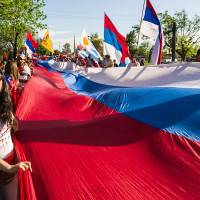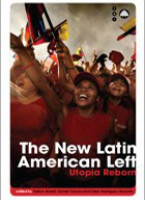50 years after the coup d’état in Uruguay A personal account of my country’s contemporary history
Regions
This June, we commemorate the fiftieth anniversary of the coup in Uruguay. My country is rarely mentioned in global media headlines – beyond our successful performance in regional or world football tournaments – but may offer useful lessons for other countries. The Uruguayan coup came just a few weeks before the overthrow of Salvador Allende in Chile and three years before the military takeover in Argentina, signalling the beginning of a dark period in Latin American history characterised by harsh political repression and the imposition of neoliberal policies that would later be replicated in other regions.
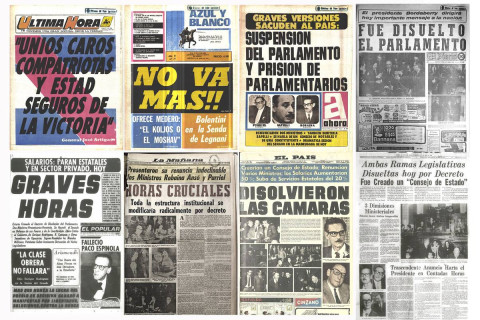
Credit: La Diaria
I belong to a generation that did not suffer the most brutal forms of dictatorial repression. When the military took power, we were in primary school. When the guerrilla movement emerged, we were being nursed by our mothers. When our parents, older siblings, uncles, aunts and neighbours were sent to prison, torture, exile or death, I was busy playing with my childhood friends or worrying about passing adolescent sorrows. I belong to the generation that grew up in a grey, sad and bitter period of my country’s history. Still, I also belong to the cohort that took part in the last wave of anti-dictatorial mobilisations, passionately celebrated the recovery of democratic institutions and freedoms, fought against the neoliberal offensive of the 1980s and 1990s, contributed to the unprecedented victories of the left in local and national elections, and been the protagonist of radical transformations in the country’s political, social and economic profile. For me and many other Uruguayans of my age, reflecting on half a century of Uruguayan history since the coup of 1973 means a review of the political, social and economic factors leading to the collapse of democracy that can never be fully objective.
The fiftieth anniversary of the coup stimulates the exercise of memory, but memory delves into the past from the present, hierarchising data and moments related to possible ways to build the future. This longread – aimed primarily at non-Uruguayan readers – offers a personal reflection on some dates, characters and tensions before, during and after the coup, with the aspiration to help prevent regressions into authoritarianism and the violation of human rights in other countries of the world.
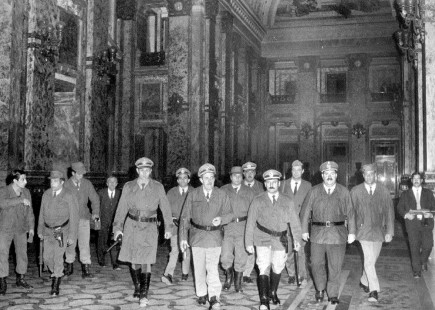
Credit: Archivo del diario El País de Montevideo
The national, regional and global context before and at the time of the coup
We remember the 27th day of June of 1973 as the starting date of the dictatorship. The institutional breakdown, however, did not occur overnight; it was the conclusion of a relatively long process of erosion of a very peculiar model of liberal democracy in a country that was and remains rather atypical in the Latin American context.
When the dictatorship began, I was in my second year of primary education at Escuela 11, a public school in a working-class neighbourhood of my city, Paysandú. I have no concrete memory of the day of the coup, but my teacher was probably giving us a lesson on Uruguayan geography: “una penillanura suavemente ondulada (a gently rolling peneplain) without the mountains, jungles or deserts that characterise other countries in the region”, as one textbook of the time put it.
But geography is not the only element that would define Uruguay’s supposed exceptionalism. Unlike most political systems in the Latin American region, characterised by weak parties with a short history, Uruguay’s two major traditional parties (which hegemonised national politics until the late 1980s) are among the oldest in the world. The Partido Colorado and the Partido Nacional were founded in the 1830s in the context of Uruguay’s birth as an independent state.
The strong party system that has historically characterised the Uruguayan political architecture also includes a left with a long history and a vocation for unity that has earned the admiration of progressive activists in other countries in the region and the world. While in other places left parties and movements are pitted against each other, in Uruguay practically all left currents – communists, socialists, anarchists, social democrats, progressive Christians and former guerrillas – came together in the creation of the Frente Amplio (Broad Front) coalition in 1971. Despite being brutally repressed during the dictatorship, the Uruguayan left re-emerged united and ascended to national office between 2005 and 2020. It is very likely (and desirable, given my militant identity) that the Broad Front will recapture the national government in next year’s election, while it runs the governments of the departments of Montevideo, Canelones and Salto, where more than 60% of the country’s population resides.
The founding of the Broad Front in 1971 resulted from earlier attempts towards unification and the synthesis of non-sectarian approaches centred on identifying two common enemies: imperialism and the local oligarchy. The construction of the Broad Front in the years immediately before the dictatorship was based on the articulation of a common political programme, grassroots organisation and a shared electoral platform. To a large extent, the unification of the political left was nourished by the experience of trade union convergence structured around a single national confederation that had managed to reposition partial and immediate demands within a coherent, far-sighted and viable programme of viable solutions for the problems of the country as a whole.
Another crucial element that has contributed to defining Uruguay’s supposed exceptionalism is the long-standing and widespread presence of a benevolent state that, during many decades, guaranteed civic, social and economic rights, resulting in an interpretation of the public as synonymous with the state and the primacy of the public realm over private affairs. The democratic-pluralist, state-driven and party-centric matrix of the Uruguayan society has also been characterised – since the beginning of the last century – by the preference for gradual and reformist paths to social and political transformation, the primacy of an urban political culture (with more than 90% of the population residing since the first half of the past century in the capital, Montevideo, and other cities). Historians also mention the creation of a peculiar welfare state at the beginning of the 20th century with the implementation of advanced labour legislation and social reforms without precedents in the Latin American region.
The Uruguayan model of state-centred development emerged in the early 20th century, during the presidential administrations of José Batlle y Ordoñéz, a political figure that today we would characterise as ‘social democratic’. In the turbulent times of the first two decades of the past century and facing growing social and political unrest, the Uruguayan state passed several legislative reforms that were very advanced for that period, including unemployment insurance, paid maternity leave, divorce at the request of the wife, and the eight-hour working day. In the following decades, the working class also conquered a system of collective bargaining that allowed negotiations between unions, employers and the state to agree on wages and working conditions. Many years later, in the context of the pandemic, a British journalist argued that Uruguay’s relative success against Covid-19 could be explained on the basis of “the good reasons citizens have for trusting the public sector”, given the existence of an “expansive welfare state that provides almost universal access to pensions, childcare, health care and education”.
Despite the particularities and historical strength of the Uruguayan democracy, the country is part of a region that was shaken by profound political and social transformations in the two decades prior to the coup. The Cuban revolution of 1959 marked the moment when Uruguay, like the rest of Latin America, internalised the logic of global confrontation that characterised the so-called Cold War. In the specific case of Uruguay, the late 1950s also marked a very significant change in the country’s history. After several decades of governments run by the Colorado Party, the democratic alternation resulting from the victory of the National Party in the election of 1958 changed the government’s orientation, with a clear shift to the right in public policy. The outcome of the 1958 election also altered the internal dynamics of the armed forces. The National Party had sought for decades to gain support among senior military officers, particularly army generals. The outcome of that national election increased the influence of officers ideologically positioned much further to the right than the generals close to the Colorado Party had been and who – until then – had controlled most of the army’s command posts.
1964 was another significant year in the timeline leading to the coup nine years later. On 1 April 1964, the military overthrew Brazil’s democratic government led by President João Goulart, installing a dictatorship that lasted for over two decades in Latin America’s largest and most populous country. The coup in the powerful northern neighbour caused much concern in Uruguay, with new worries about the prospect of similar events at home.
At the time of the coup in Brazil, the US government feared a communist takeover. The White House and its embassy in Brazil were concerned as the biggest country in South America veered to the left during the Goulart administration. Although those in charge in Washington DC denied having any part in the Brazilian coup, plenty of evidence shows their support for the putschists. Then US President Lyndon B. Johnson immediately recognised the military regime as legitimate, as US governments continued to do following the coups that took place across the region in the 1970s and 1980s. A widespread joke in Uruguay and other Latin American countries is that there will never be a military coup in the United States because that country does not have a US embassy.
The next key year in the timeline towards the coup was 1968. By then, the Uruguayan political system – which in previous decades had achieved regional and global recognition as a solid democracy – increasingly began to resemble more and more what the acclaimed Uruguayan writer Eduardo Galeano characterised as a democradura, referring to a particular type of government that maintains the formal structure of a liberal democracy but with strong authoritarian and repressive features, short of becoming a full dictatorship. A characteristic of the five years immediately preceding the 1973 coup was the abusive use of legal norms to repress social and political protest through the frequent use of the mechanism of medidas prontas de seguridad (prompt security measures), a temporary limitation of individual freedoms and guarantees provided for in the Constitution for very exceptional situations.
In February 1973, a military rebellion took place, which included the proclamation of a series of demands aimed at changing the orientation of government policies. The insubordination weakened the authority of the increasingly authoritarian President Juan María Bordaberry. From that moment on, with the formation of the National Security Council (COSENA), military co-participation was instituted in decision-making in matters that transcended the historical competencies of the armed forces.
The shift to the right that took place in the Uruguayan government after 1959, which included a series of structural adjustment programmes, had been enthusiastically supported by the sectors of the bourgeoisie in control of the national economy. The rise to the presidency of Jorge Pacheco Areco in December 1967 was applauded by business circles that demanded an authoritarian reaction to deal with the wave of growing trade union mobilisation and social protest.
In 1973, the regional context in the region was very favourable for the coup plotters. Paraguay had been an authoritarian regime since 1947, and Alfredo Stroessner had ruled as dictator since 1954. On the other side of the Rio de la Plata, in Argentina, the military had already overthrown the democratic government in 1966. Brazil and Bolivia had military governments from 1964 and Peru since 1968 (although the latter represented a somewhat different political orientation from the other dictatorships). In Chile, the socialist Popular Unity government faced the combined pressure of the national oligarchy and transnational capital. In most of Latin America, the health of democracy was fragile, with frequent outbreaks of political violence and curtailment of freedoms against a general backdrop of direct or indirect US intervention. The US government, after the incorporation of Cuba into the socialist camp, was determined to prevent the enemy’s advance in its ‘backyard’ and intensified the training of Latin American militaries in ‘counterinsurgency’ to establish a continental mechanism for surveillance, repression of dissent and support to authoritarian regimes aligned with its political and economic interests.
In the supposedly more democratic and stable Uruguay, the political, social and economic landscape had long since ceased to be idyllic or different from that of neighbouring countries. Since the mid-20th century, the economic crisis had been tackled by successive governments with market-driven policies that had a severe impact on vast sectors of the working class. Growing social protests by workers and students were ignored or brutally repressed. The urban guerrillas – mainly the Tupamaros National Liberation Movement (MLN-T) – which had amassed relatively broad social support in the late 1960s and early 1970s, were already militarily defeated. However, the coup plotters still pointed at the guerrillas as an excuse for democratic breakdown. The hope for social change that had arisen with the creation of the left-wing coalition Frente Amplio in 1971 was extinguished with the electoral triumph of the right in the same year. The two major traditional parties had lost credibility, weakening the historical foundations of the republican democratic system that had characterised Uruguay for decades.
The dictatorship, the military, economic power and collaborationists
The dictatorship was brutal. The military and civilians who usurped the government for 11 years (until February 1985) implemented a sinister programme of state terrorism. Thousands of men and women of all ages were kidnapped, tortured, deprived of their freedom, held in official or clandestine detention centres, murdered or forced into exile. More than 7,000 people, including adolescents, were sentenced by military tribunals without legal assistance or guarantees. 197 Uruguayan citizens, many outside the country – in the framework of the Plan Cóndor, a scheme for the coordination of repression devised by the dictatorships of the Southern Cone – are still desaparecidos (missing). More than 200 people were killed in extrajudicial executions, in bloody operations by the security forces, in prison, or in the torture chambers.
The military did not act alone, and the dictatorship could be foreseen some years ahead. The holders of economic power that supported the repressive measures imposed by the democraduras led by Jorge Pacheco Areco and Juan María Bordaberry (the two far-right presidents before the military assumed full control of the government) were the same ones that celebrated the closure of Parliament in 1973 and participated in the design of the National Development Plan 1976-1977, representing business interests linked to the right-wing factions of the two traditional parties.
Also important was the support given by a network of intellectuals – of a similar profile and ideological orientation to the Chicago Boys who backed the dictatorship led by Augusto Pinochet in Chile – who converged around the economic and political weekly Búsqueda. These academics, researchers and journalists presented themselves as liberales, but made clear that if it were necessary to limit political freedom in order to build the much sought-after economic freedom, they were prepared to accept that trade-off. Other social and political sectors that supported the dictatorship were the far-right factions of the two traditional parties, conservative Christian networks and neo-fascist paramilitary bands that had emerged in the mid-20th century.
As had happened before in Brazil, the military coup leaders were interested in controlling the government to launch a much broader economic and social project and actively participate in the design and implementation of public policies. Within business circles, although there was no unanimous agreement with the military’s ideas and actions, there was widespread concern about the uncertain course of the government’s economic management at the time and a shared interest in reducing the influence of the trade union movement.
Beyond the support of other political and economic agents, the military was the central actor in this process, which had ‘purged itself’ by eliminating internal factions opposed to the coup. The purge also included the marginalisation (and, according to some historians and journalists, even the physical elimination) of peruanista officers, meaning military officers interested in taking power to promote ‘progressive’ social and economic reforms such as those implemented by the Peruvian military after General Juan Velazco Alvarado overthrew the democratic government of that country in October 1968.
The existence of a large sector of Uruguayan society that passively supported the coup must also be taken into consideration. Many ordinary men and women who were not active in political or social organisations did not oppose the violent takeover, similar to what was later observed in Chile and Argentina when the military overthrew the democratically elected governments of those countries. Although there were no systematic public opinion surveys at the time, in May 1973, the Gallup survey company conducted a very revealing poll. According to the survey, 52% of respondents said that the military’s accusations of corruption against politicians (a powerful thrust of the military’s discourse to justify the dissolution of Parliament) were true, and only 27% said they were exaggerated. In the same vein, 60% agreed that members of Parliament did not care about the welfare of the people, and 70% felt that parliamentarians abused their great privileges, while 44% believed that the military was more respectful of the Constitution and laws than politicians and only 23% said the opposite. It is impossible to verify the quality and methodological rigour of that survey. Still, these data give an idea of the discrediting of the political elite that coincides with the conclusions of other social research at the time. Faced with this reality, the civilian-military coalition that took political power in June 1973 proposed dismantling the so-called “ideological apparatuses of sedition”, including all political parties, trade unions, educational institutions at all levels, and the press.
The terrible wounds caused by the dictatorship are still open. The dissolution of the Uruguayan Parliament in June 1973 induced the reconfiguration of a society that, despite the five decades that have passed, has still not been able to fully rebuild itself. I live outside my country for personal reasons but never went into exile. Tens of thousands of Uruguayans older than me had no choice: they were forced into exile, and most of them never returned. According to data compiled by demographers at the University of the Republic (my university, proudly public), migration records showed a negative balance of 310,000 people between 1963 and 1985, equivalent to 12% of the population in that period. Net emigration rates peaked between 1972 and 1976, showing the impact of the worsening political crisis and the advent of the dictatorship.
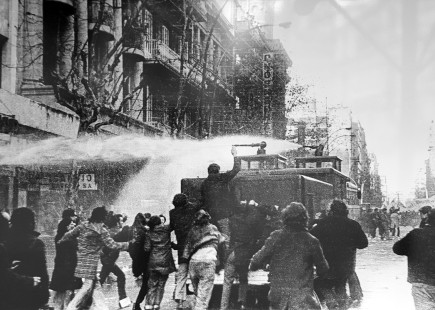
Credit: Aurelio Gonzalez
The resistance
In some ways, the dictatorship was the expected response to the intense political and social unrest that had characterised Uruguay in the previous decade. From 1959 onwards, successive governments experimented with market-driven policies. Economic problems, the rising cost of living, the fall in real wages and the spread of social struggles were met with repressive responses from the state. In 1962, the marches of the cañeros (sugar cane workers) made visible the existence of ‘another’ country, very different from the urban Uruguay, and contributed to the radicalisation and unification of the trade union movement. The 1960s saw the strengthening of coordination between various state workers’ unions (in a country with an extensive public administration system and a large network of state-owned enterprises) and the rapprochement between diverse ideological tendencies active within the labour movement.
During the 1960s, Uruguay was affected by stagflation, with a stagnant economy and double-digit inflation derived from the political system’s inability to come up with an alternative to the import substitution model. In that context, in 1965, the trade unions organised the Congreso del Pueblo (the People’s Congress), in which representatives of trade unions, students, cooperatives, pensioners, intellectuals and small-scale entrepreneurs took part. The organisations represented at the People’s Congress agreed on multiple proposals to address the economic and social crisis, which affirmed the urgent need for radical reforms in land ownership, foreign trade, the industrial and banking sectors, taxation and education. In this context, in 1966, the Convención Nacional de Trabajadores (National Workers’ Congress, CNT), the body representing labour and coordinating workers’ struggles throughout the country, was born.
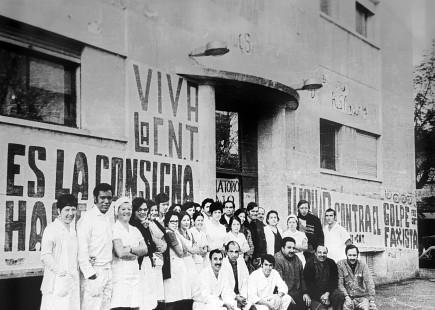
Credit: Aurelio González
In the five years before the coup, social struggles intensified and political violence worsened, in particular the confrontation between guerrilla organisations and the government. The state repression included the banning of five left-wing parties and the closure of opposition media. The Colorado Party’s conservative candidate Juan María Bordaberry won the election of November 1971. A few months later, on June 1973, the coup was carried out by Bordaberry and the armed forces with the firm support of the business chambers and right-wing political sectors. The CNT and the Federation of University Students (FEUU) called a general strike, occupying workplaces and university premises until 12 July. The strike ended with hundreds of workers and students arrested and thousands of strikers dismissed without compensation. With the CNT outlawed, the unions went underground. Resistance took many creative forms throughout the period, including organising in the political prisons and in many countries worldwide where trade unionists and left activists had gone into exile.
In 1980, the ruling military called a plebiscite to approve a new and highly authoritarian constitutional text. Despite the government’s strong propaganda campaign and the absence of spaces for anti-dictatorial campaigning, the result surprised the world: the citizenry rejected the constitutional reform with 57% of the votes, which ultimately triggered the process of democratic opening.
My first steps as a social and political activist took place in my city, in 1982. By that time, the dictatorship had authorised the functioning of the two traditional parties and called for internal elections, in which the democratic sectors of the National and Colorado parties triumphed. The left, still banned and with its main leaders in prison or in exile, called for a blank vote. Despite my mother’s pleas for me not to get involved in political activities, together with high school classmates, at night I distributed leaflets and painted graffiti on the walls of Paysandú calling for a blank vote.
During the last two years of the dictatorship, social mobilisations in the streets intensified. In April 1982, the Social and Cultural Association of Public Education Students (ASCEEP) was created, which revived the militant tradition and spirit of the FEUU and other pre-dictatorship student organisations. Human rights organisations were also strengthened, particularly the Peace and Justice Service (SERPAJ). The trade union movement resurged: in 1983, a group of young trade unionists organised the first May Day rally around the call for ‘Freedom, Work, Wages and Amnesty’, giving rise to the Plenario Intersindical de Trabajadores (Inter-unions Plenary of Workers, PIT). The commemoration of May Day 1984 expressed the symbolic convergen of two generations of trade union militants, the younger (PIT) and the older (CNT), under the slogan “a unified trade union movement” and renaming the trade union confederation PIT-CNT.
Another significant social actor in the struggle against authoritarianism was the cooperative movement, in particular the Federación Uruguaya de Cooperativas de Vivienda de Ayuda Mutua (Uruguayan Federation of Mutual-Aid Housing Cooperatives, FUCVAM). My father, Lucio Chaves, was one of the founders of Covisan 9, a workers’ housing cooperative where I grew up on the outskirts of my city. Faced with the banning of trade unions and the closure of other associative spaces, the housing cooperatives – which since the late 1960s had spread throughout the country – became a privileged space for working-class organising. On 26 February 1984, FUCVAM launched a national day of struggle against a resolution that forced cooperatives to abandon collective ownership of the housing units. Together with other members of my family and friends from my neighbourhood, we went around the city collecting signatures in defence of housing as a commons. The day ended with more than 300,000 signatures collected in less than 12 hours (in a country of three million inhabitants), which is remembered as one of the milestones in the struggle of the Uruguayan people against authoritarianism.
In November 1984, I voted for the first time, in an election that had emerged from an infamous pact between the generals and the leaderships of the two national parties, with the candidates of the left still banned and many comrades still imprisoned. The election resulted in the triumph of the Colorado Party and the reopening of Parliament and all democratic institutions. Uruguayans recovered public freedoms, political prisoners were released, and many activists returned from exile.
Sadly, the return of democracy did not mean justice for the victims. In 1986, despite strong opposition from Broad Front legislators, the two traditional parties that held the majority of seats in Parliament passed a piece of legislation with a ridiculous name and awful contents: the “Law on the Expiry of the Punitive Claims of the State”, which blocked the prosecution of military personnel and civilian collaborators accused of violating human rights during the dictatorship. The trade unions, the student organisations, the cooperative movement and human rights defenders swiftly organised and called for a referendum against that resolution in April 1989. Still, the votes were insufficient to repeal it: 56% of the citizenry reaffirmed the impunity law.
Uruguay: one of the first real-world laboratories of neoliberalism
My decision to study (becoming the first in my family to go to university) and then go into political economy was largely influenced by the social environment in which I was born and raised and the daily difficulties my family had to overcome during the dictatorship. I am the youngest of seven children of a father who worked in a factory in the food industry and a mother who was a domestic worker for four decades. During the dictatorship, with inflation rising and the purchasing power of wages shrinking, my family – my mother, in particular – had to carefully manage the scarce resources available to buy food and other necessities. My family’s experience was not unique, as the poverty and inequality resulting from the economic policies of the time radically altered the mesocratic profile of the Uruguayan society.
The dictatorship became an ideal laboratory for experimentation with neoliberal ideas. I understand neoliberalism (one of my main research interests during the past two decades) as that current of economic thought centred on the supposed central role of the market and leading to policy strategies that seek greater commercial and financial liberalisation, the deregulation of economic activities and the reduction of the role of the state in economic and social affairs. Although we, Uruguayan researchers interested in these issues, like to disagree on the characterisation of the economic model applied between 1973 and 1985, we tend to agree that the dictatorship did not establish a new or original model but rather deepened the policies of liberalisation and deregulation that had been partially applied since the approval of the monetary and exchange rate reform of 1959.
At first, between 1973 and 1977, the dictatorship was reluctant to apply neoliberal prescriptions in their purest form. The severity of the political and economic crisis forced the government to try to reduce inflation and stimulate growth after two decades of stagnation. A phrase the military and other government officials repeated at the time was “security for development and development for security”. They proposed, therefore, the industrialisation of the economy based on support for ‘non-traditional sectors’ to export, with the introduction of tax exemptions, credit facilities, tariff advantages and price controls. At the same time, a harsh wage policy was implemented, which, by reducing the real income of workers, lowered the costs of private companies and reduced the relative share of wages in the country’s GDP. According to official data, between 1973 and 1984, workers’ earnings fell by an average of 50% in real terms.
More in line with neoliberal orthodoxy, from 1974 onwards, economic policymakers focused on attracting foreign capital to increase investment and accelerate the liberalisation and external opening of the Uruguayan financial system and the foreign exchange market. In 1974, the Central Bank of Uruguay (BCU) allowed the free convertibility of the national currency (the peso) for domestic and international financial transactions and the free transferability of capital. In 1976 the compulsory tender of the national currency and the banks’ foreign currency ceilings were eliminated, with the foreseeable consequence of a large-scale dollarisation of the economy.
From 1978 onwards, another important shift took place, with the abandonment of the idea of growth based on export-led industrialisation and a strong commitment to deregulation and trade liberalisation. At the same time, the Ministry of Economy publicised the intention of turning Uruguay into a regional financial hub. Likewise, the persistence of inflation led to the implementation of a stabilisation plan based on the gradual devaluation of the currency with a pre-announced daily exchange rate. Price controls and mandatory reserve requirements were eliminated, and the interest rate was liberalised. In November 1979, the tax system was modified by removing the charges on bank deposits and foreign earnings, while the range of activities to which the value-added tax was applied was widened and its basic rate was raised, with serious impacts on working families’ capacity to access basic goods and services.
In 1982, following Mexico’s moratorium on debt payments, which provoked a shock that caused the international financial system to cut off the flow of capital to Latin America, external credit to the Uruguayan economy was halted. That restriction increased the demand for dollars and triggered a sudden devaluation in November of that year when the BCU depleted its reserves. The stabilisation plan collapsed and the dollar soared, causing serious damage to local individuals and companies indebted in foreign currency.
As a result, Uruguay’s external debt quadrupled between 1981 and 1982. Moreover, the banking crisis generated by the difficulties in recouping dollar-denominated loans led the government to take over the bad debts of bankrupt private banks. These measures, which came at a high cost for public finances and society as a whole, paired with the deep slump in the world economy and the debt crisis in Latin America, contributed to plunging Uruguay into a recession that would last until the end of the dictatorship. Between 1981 and 1983, Uruguay’s GDP fell by 15%, while at the industrial level the fall was even more pronounced, at 23%.
Five decades after…
Fast forward to 2023... Uruguay has once again become a beacon of democracy for Latin America and the world. According to The Democracy Index compiled annually by the Economist Intelligence Unit (which provides a snapshot of the political situation in 167 countries based on indicators that monitor the electoral process and pluralism, civil liberties, the functioning of government, political participation and political culture), there are only 22 full democracies in the world today, and my country is one of them. Uruguay ranks 11th in that index, the highest in the Americas and above many supposedly more advanced countries, such as Canada, Germany, Australia, Japan, the United Kingdom, Austria, Spain, France and (obviously) the United States.
The current Uruguayan democracy is far from perfect, but those of us who suffered the dictatorship learned to appreciate the importance of political freedoms, elections, political parties, an independent judicial system, the Parliament and other components of liberal democracies. Five decades later, with the experience of dictatorship behind us, Uruguayans value democracy and have learned that its absence is far worse than its shortcomings and flaws. In this framework, the left – which in the years before the institutional collapse had become accustomed to conceiving of political violence as a natural result of social injustice – has repositioned itself as the country’s most democratic political force and the most averse to authoritarianism (with a few and criticisable exceptions).
Moreover, despite the social devastation caused by the economic policies of the dictatorship, Uruguay managed to recover its historically high social welfare indicators and is now characterised as a very high human development country by the United Nations Development Programme (UNDP).
Uruguay remains the most socially advanced and least unequal country in Latin America. Still, the gap that widened during the dictatorship has not narrowed, and the economic cabinet of the current government seems to be reading from a manual written by the hard-core neoliberal ministers of the dictatorship. Between 2019 and 2022, the share of wage earners in the country’s GDP fell by 2%, while the share of capital increased by the same proportion, according to data from the National Institute of Statistics (INE) and the BCU. At the same time, poverty grew: today, there are 42,000 more poor people than in 2019, of which almost 20% are children. The economic policy of the dictatorship intended a savage deregulation of the labour market based on trade union repression. The aim was to lower labour costs to increase corporate profits. Consequently, wages were adjusted downwards during the whole authoritarian period. The similarity between the policies applied by the conservative coalition in office in Uruguay since 2020 and by the dictatorship five decades ago is not a mere coincidence.
The legacy of the coup is still observable on many fronts. As I write this text, I read in the Uruguayan press that forensic anthropologists from my university have found bone remains buried in a military barrack on the outskirts of Montevideo. According to the organisation of mothers and relatives of desaparecidos, those bones are almost certainly the remains of a compañero murdered by the executioners of state terrorism. Some of the most recognisable murderers and torturers of that time, military and civilian, are finally in prison. Many others, however, are still free or have died without being tried by any judge.
Last 20 May, as every year, a tide of tens of thousands of people marched down Montevideo’s main avenue to demand verdad y justicia (truth and justice) for the 197 men and women who went missing after being detained by security forces between 1973 and 1984. Carrying black and white posters with the faces of the desaparecidos and daisies, the symbol of the cause, the demonstrators reaffirmed the demand from a clear response from the state. At the end of the marcha del silencio (the silent march), Alba González, mother of the disappeared Rafael Lezama – a student activist who was 23 years old when he was disappeared – read a statement in which she demanded “with more strength than ever the search for our relatives, which cannot continue to be a blind search. It is necessary that those who have information give it. It is urgent to break the silence and halt the culture of impunity”.

